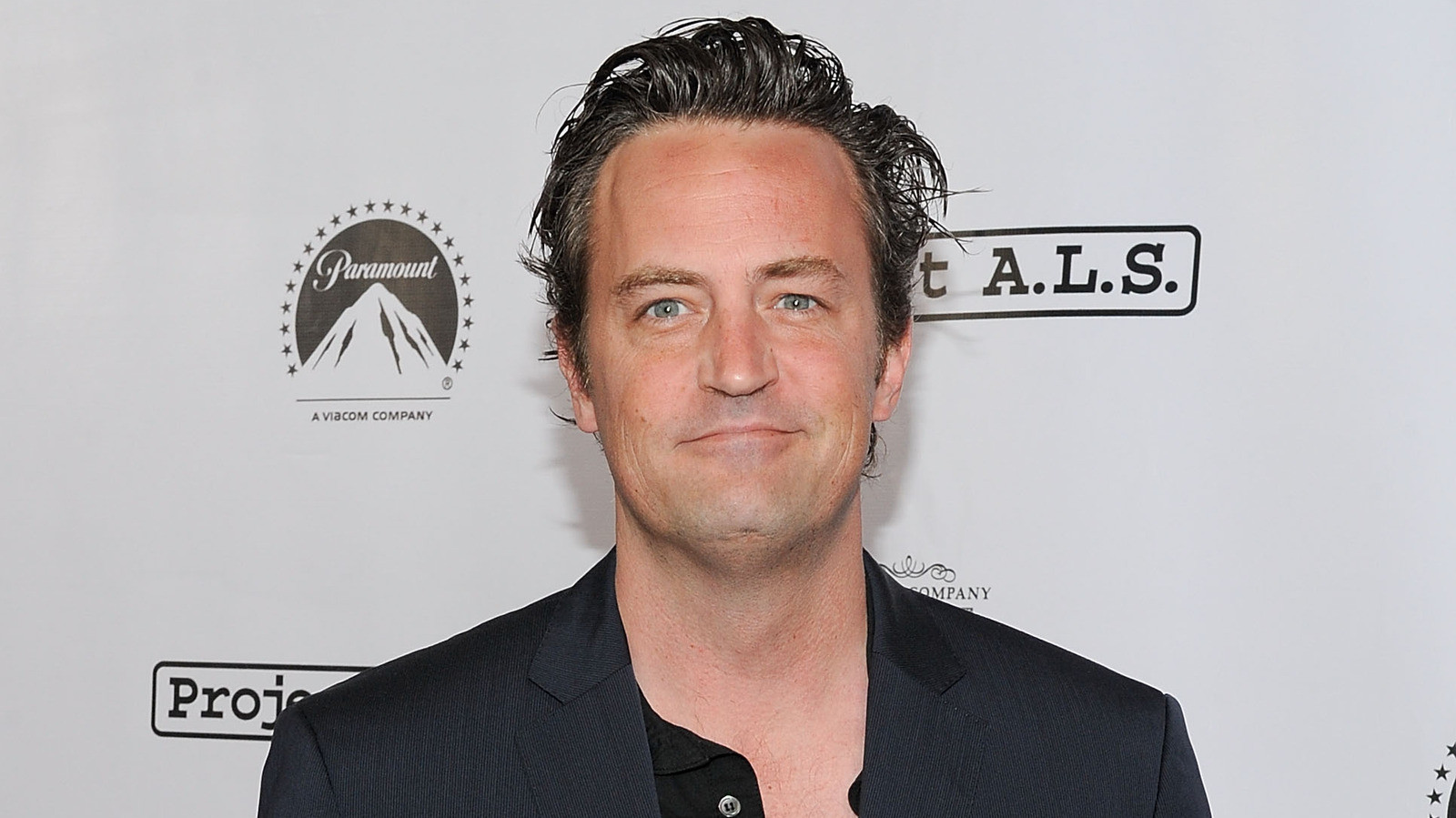The facts surrounding Perry’s demise are screwy from the start, with each new revelation just adding to the whole dreadful unreal only-in-Hollywood-maybe tilt and swerve. Most recently, in mid-August, came the arrests of the five individuals most likely responsible for funneling insane amounts of ketamine into Perry’s life: two doctors who seemingly tossed their Hippocratic oaths to the wind, a movie director who allegedly acted as a go-between to a drug dealer known as the Ketamine Queen, who was also indicted, and finally Perry’s live-in personal assistant, Kenneth Iwamasa, who was injecting ketamine into Perry up to eight times a day for weeks, into the afternoon of October 28, 2023. On that day, according to the plea agreement he reached with authorities, Iwamasa gave Perry one shot at 8:30 in the morning, after which the actor went to play pickleball (how he managed to do that while under ketamine’s influence is beyond me), then returned home to watch a movie, got another injection at 12:45 p.m. and 40 minutes later asked Iwamasa for yet another. At the time, he was either sitting near the Jacuzzi attached to his swimming pool or already in it. He said, “Shoot me up with a big one.”
The boss was a household name, had become famous overnight playing sweetly, sarcastically neurotic Chandler Bing in the gigantic hit TV show Friends from 1994 to 2004, once dated Julia Roberts, already survived all kinds of addictions and related medical emergencies, had published an autobiography recounting same with painful, courageous honesty, as a kid growing up in Canada once gave future prime minister Justin Trudeau a pounding, was widely beloved even as his post-Friends career went sideways, and no doubt trusted Iwamasa, who had been serving Perry in a variety of roles for at least 25 years, to do right by him. No matter that in the past month Iwamasa had more than once found Perry, post-ketamine injection, laid out cold inside his $6 million bluff-top pad on Blue Sail Drive, in Pacific Palisades, views all the way to the sparkling sea, with him inert, unable to move or see a thing.
But that was then, and Perry’s needs were now. Iwamasa loaded him up, as requested, then took off to run errands, returning a few hours later to find his boss upside down in the Jacuzzi. He hauled him up onto the steps, arranged him in a seated position, called 911, and spent some portion of the next 17 minutes rushing around, hiding anything to do with ketamine — needles, vials, anything — as Perry himself, him just slumped there awaiting the sirens.
Upon arrival, paramedics moved Perry to the lawn where he was pronounced dead at 4:17 p.m. Age, 54. Weight, 216 lbs. Blue eyes, blond hair, natural teeth. Healed amputation of middle right finger, the distal end, noted. At least 136 pictures of the scene taken. Also noted: He had a long history of drug abuse, which had apparently ended 19 months prior. As well: “His last ketamine treatment was a week and a half ago.”
Meanwhile, investigators found lots of things in the house: “multiple open, empty, half-filled medication bottles… over-the-counter medications, vitamins, digestive aids, and dishes filled with multiple loose pills, tablets, caplets, candy and breath mints… multiple nicotine vaping products and an inhaler… nicotine lollypops,” etc., etc., and so forth, to deal with depression issues, hair-loss issues, testosterone and erectile issues, diabetes issues, addiction issues, acid-reflux issues, weight issues, an entire panoply of issues common to lots of people. But more to the point: “Officers observed no evidence of illicit drugs, drug paraphernalia, foul play or trauma.”
In short order, of course, the truth came out. At the time of death, the ketamine blood levels found in Perry’s body were roughly eight times the levels that would have been produced by the 1.2 mg/kg dose I received for my last trip — the deliverance one. Mine had been enough to sink me far down into the so-called k-hole, near to the point of a suddenly feared terminal destination. With eight times that amount in Perry’s body, one can only wonder where he and his thoughts were in his final moments, if anywhere at all.
From the medical examiner’s report: “Cause of death is determined to be from the acute effects of ketamine. Contributory factors … include drowning, coronary artery disease and buprenorphine effects. The manner of death is accident (drug and drowning related). At the high levels of ketamine found in his postmortem blood specimens, the main lethal effects would be from both cardiovascular overstimulation and respiratory depression.” The report goes on to note that buprenorphine, a weak, legal opioid used to treat addictions to much stronger ones, can have “additive respiratory effects when present with high levels of ketamine.” Iwamasa’s plea agreement with authorities stated things a little more bluntly: “Defendant admits that Victim M.P.’s death was due to effects of ketamine and that but for the presence of ketamine in Victim M.P.’s bloodstream, Victim M.P. would not have died on October 28, 2023.”
This has led to a certain amount of upset among the ketamine-positive crowd, the feeling being that drowning killed Perry, not ketamine, and to place ketamine in the first position can only lead to more headlines like this recent one in the New York Times: “Matthew Perry’s Death Shines a Harsh Light on Ketamine Treatment.” On the face of it, it’s clearly misleading, since Perry’s death had very little to do with ketamine treatment, only its abuse. But large type declaring that his death casts “a Harsh Light on Ketamine Abuse” — it just wouldn’t have the same ring.
“I remember thinking the conclusions were funny, because there isn’t a mechanism for ketamine to kill somebody,” says Dr. David Feifel, the psychiatrist who runs the Kadima Neuropsychiatry Institute. He’s one of the treatment’s earliest adopters, starting back in 2008, and one of its leading voices. He’s also the doctor who administered my treatments. “As you know, one thing that happens with ketamine is you lose motor control. You can’t stand up and walk around. You have to be watched. But you do have internal thoughts, like your vivid description of the crimson church. Oh, my gosh. But Matthew Perry was tripping, had no control over his body, and slipped under the surface and drowned. To do ketamine in water is the height of insanity. So that’s why I can’t understand why drowning isn’t listed as the cause of death.”
The medical examiner’s office denied a request for clarification (nor would it say why no needle marks had been found on Perry’s body).
In the wake of Perry’s death, anti-ketamine agendas abound. An example: Shortly after the arrests in mid August, DEA Administrator Anne Milgram went on CBS’s Face the Nation, where she compared the current level of ketamine abuse, brought about by over-prescribing, over-enthusiastic doctors, with the beginnings of the opioid epidemic, not bothering to note that it’s nearly impossible to OD on ketamine unless other drugs or stupidity are involved. She spent the rest of the segment detailing the OD-easy horrors of fentanyl and its widespread, often-fatal abuse, as if the two drugs were somehow similar. Nor did she mention that even her own agency classifies ketamine as a fairly low-risk schedule III drug, since it has only low-to-moderate potential for psychological or physical dependence, similar to certain steroids and drugs with codeine, or that in May the Department of Justice moved to reclassify marijuana as a schedule III drug, too. Meanwhile, fentanyl and the other opioids remain schedule II drugs due to their “high potential for abuse,” having killed 81,806 people in 2022, the last year for which total statistics are available.
KETAMINE HAS BEEN AROUND as an anesthetic since the 1970s and was widely used during the Vietnam war. It is still used in operating rooms and is on the World Health Organization’s List of Essential Medicines. It’s also favored by veterinarians, hence why it’s sometimes called Cat Valium.
How it wound up in the club scene, gay or straight, is unknown, but it took hold in the 1980s and by the late 1990s rivaled MDMA in popularity, especially among ravers, due to its dissociative properties. Snort a line, and you were floating in Jell-O, time and space all gone wonky. In 1998, one user reported to the club-culture magazine Muzik that “I’d taken speed, MDMA, acid, coke, even crystal meth before I got to K, but there’s something supernatural about ketamine which separates it from all the other drugs.” Indeed, even the grand wizards of the psychedelic scene were high on the stuff.
In 1996, I happened to visit Timothy Leary, the Harvard doctor famous in the 1960s for advocating the use of LSD (and for telling hippies everywhere to “turn on, tune in, drop out!”). At the age of 75, he was resting on a bed while youngsters in another room diligently fiddled with a bunch of wires and odd-looking machinery apparently designed to keep his body frozen in suspension after he signed off. He did a lot of smiling and nodding though not a lot of talking. That changed when his old friend John Lilly, inventor of the sensory deprivation tank, showed up. Suddenly, he was all whispers and laughter. And then his door shut. I asked one of the kid scientists what they might be doing. He looked at me as if I was an idiot, shrugged and said, “Ketamine.” I asked him what that was. I got the look again. Interestingly, a cousin drug to ketamine is the much more dangerous drug PCP, also known as Angel Dust, a real killer, and in the 1970s, when PCP abusers went searching for a way out of feelings of helplessness, they often turned to ketamine. It wasn’t until 2000, more or less, that the medical community started looking at it as a treatment for major-depressive disorder, bipolar disorder, and suicidal ideation. The results were impressive, so much so that in 2019, the FDA approved a nasal-spray version of the drug, called esketamine, and in 2020, a review in a scientific journal called ketamine one of the “most important discoveries of the last half century.” Since then, use of the drug, also known as Special K, Kit Kat, Vitamin K, Jet, and Special la coke, has most certainly grown, both by abusers and in legitimate settings.
But back to my own agenda, pro-ketamine though it may be: Perry the human being as opposed to Perry the talking point, or at least back to an admix of the two. Another of the curiosities in the medical examiner’s report is an interview done with one his friends. This woman reported that Perry had told her he wasn’t suicidal, that he was taking a 30-mg daily dose of Subutex (a.k.a. buprenorphine a.k.a. Bupe) but hoped to wean down, had stopped smoking two weeks before, and “was having ketamine treatments: his last doctor was treating him more frequently, and he was having treatments every other day; but his new doctor of 6 months stated that since he was in a good mood, his depression was fine, and he did not need more treatments.” Finally, she noted that Perry “had been sober for 19 months with no known relapse.”
Sober? I suppose that all depends on what you mean by sober. Iwamasa, the personal assistant, had been injecting Perry with illegally obtained ketamine, at home, for at least a month, six to eight times a day toward the end. Even before that, getting every-other-day ketamine treatments in a doctor’s office is a protocol no one I’ve spoken to recognized. (It should be noted that one of his doctors did refuse a request to up his dose.) Further, he was taking Bupe, a weak opioid but an opioid nonetheless. “He had quit smoking. He was getting in shape. He was happy — that’s all I know,” Jennifer Aniston said after his death. Perhaps. But it hardly seems like he was sober.
But what was he looking for with all that ketamine? What were his expectations? What did he want out of it?
In his 2022 memoir, Friends, Lovers, and the Big Terrible Thing, Perry said he’d spent half his life either using stuff that was bad for him, fighting to not use it, or looking for help in rehab facilities. Half his life. He’d started drinking when he was 14 and never really stopped searching for a way out or around what was bothering him. Nothing worked, not even stardom, which he’d thought would be a sure fix. Regardless, he was widely considered to be a great guy and, indeed, no scandals other than drug-related ones (leading to a few anger-issue reports) ever touched that belief. So on he went, good old Matthew Perry.
He first encountered ketamine during the Covid pandemic, at a swank rehab joint on Lake Geneva, in Switzerland, ostensibly to deal with pain and depression. In his autobiography, he says he was put on hour-long infusion drips and listened to Bon Iver on headphones. “I would disassociate, see things. … Oh, there’s a horse over there? Fine — might as well be… It all became about the ego, and the death of the ego. And I often thought I was dying during that hour. Oh, I thought, this is what happens when you die. Yet I would continually sign up for this shit because it was different and anything different is good…. Taking K is like being hit in the head with a giant happy shovel. But the hangover was rough and outweighed the shovel. Ketamine was not for me. Back in my room, the butler had laid out more clothes I wouldn’t change into … and I went back to looking at Lake Geneva a lot, completely fucking high.”
Reading this the first time stopped me cold.
HERE’S HOW KETAMINE used in a medically supervised setting is typically supposed to work. You take the drug with a doctor and nurse attending. You experience the trip and then you wait before taking another. Might be a few days at the start, or a week or two. Exact protocols have not been established. But the point is, you wait to see if your presenting symptoms have changed, perhaps with the continued assistance of talk therapy. In a nutshell, those are the basic elements of what hopefully succeeds where everything else has failed, pills, visits to a shrink, the usual that can often be stymied by thornier psychological issues, among them treatment-resistant depression, PTSD, OCD, and more. How it works in this regard isn’t entirely understood but Dr. Kent Robertshaw, an addiction expert with the Positive Mind Center in Manhattan, gave me a pretty good layman’s explanation.
“It’s kind of like a shock treatment that breaks pervasive negative loops that antidepressants can’t get to,” he says. “Actually, there’s two things that are going on. One is breaking the loop in the head. The other thing is the other side.”
Ah, yes, the other side, the other side being those days and weeks after the trip. During my last trip, into and out of the great crimson corduroy cathedral, I didn’t cry, since I don’t (or can’t) cry; not even ketamine can touch everything all at once. But I did not soil myself, I did not lose my skin, and I did say, “Halp, hey, halp.” What those words meant wasn’t as obvious as you might think, at least not to me. Took a while. Took me canceling my next ketamine appointment to wonder why I hadn’t recently felt my childhood rising up to pound me into the ground and remind me of how skin smells under pressure from a smoldering Diamond Ohio Blue Tip Strike On match, pressed in and held there by someone who is supposed to love you.
It pains me to write those last few words. And doing so does threaten me. But as of today, at this hour, the loop remains broken. “Halp, hey, halp.” I rarely ask for help for anything. Asking scares me. But down there under ketamine’s influence, I managed to squeak out the words and then, weeks later, realize their significance. In my case, and in most of the cases that I’ve heard and read about, ketamine can work wonders, but for it to work, you have to allow it to work. As Kadima’s Dr. Feifel says, “The trip is over but something has changed in your brain, which helps you cope better. That’s the therapeutic effect, which is not just an effect of being under the acute influence of the drug.” And that’s a thing that Perry seemed incapable of allowing into his world or even that his legit doctors and rehab centers went to any lengths to enforce. All he seemed to get out of his Switzerland experience was a hangover and a stoned return to his view of glorious Lake Geneva.
To some observers, Perry was nothing more than an addict displaying addict behavior from his first trip to his last, never a moment’s peace for him, never a pause to gather himself and his senses, only money to spend, lies to tell and corners to cut, charmingly, disarmingly at all times, into order to get his everyday addict’s needs met, the same for him as for anyone else, rich or poor, similarly unable to get help or even ask for help. And then the observers write him off. Found in the comments section of a Washington Post story about Perry: “Who cares about a wealthy addict who probably decided to commit suicide? Stop writing this rot already.”
Meanwhile, anyone who wants to try ketamine at home these days can get it for just a few bucks. The doses will be small compared to Perry’s, but no longer does a taste of the experience require a trip to a clinic, $600 and up, or connections to a ketamine queen and the ketamine underworld. Instead, head on over to Facebook, search the word “ketamine,” and soon enough your feed will give you an infinite number of ways to undergo “therapy” at home. On offer from Joyous are microdoses, “affordable! Only $129/mo.” Or “take control of your wellness” via Better U Care’s at-home ketamine package, four sessions for $500. Sure, you’ll have to deal with a few leading-to-the-answer-type questions to qualify but that’ll be no biggie. And afterward, if you come out of one of your trips with a sudden burst of entrepreneurial energy, Ketamine Academy will happily instruct you on the ins and outs of creating your very own “incredibly rewarding” ketamine clinic at a hefty discount.
All this is possible due to an oddity in FDA regulations that lets doctors of almost any kind write off-label ketamine prescriptions to just about anyone. And for all the uproar surrounding the resulting uptick in off-label ketamine use and abuse, the number of deaths is apparently so low that they are not even tracked by the government. Overdose statistics for opioids (fentanyl and the like) have been collected for more than 20 years, but no similar stats exist for ketamine, which takes a certain amount of credibility away from DEA administrator Milgram’s warning that we are verging on a ketamine-abuse epidemic to rival fentanyl’s.
“I don’t know that we have any numbers that can support that [conclusion],” a spokesman for the CDC’s National Center for Health Statistics told me. “Using our death certificate data, which is how we identify numbers, ketamine is coded in a category like ‘poisoning by other’ and we can’t break it down within a category. We don’t have [the numbers] for comparisons.”
On the other hand, what we could see soon is lots more people walking around your neighborhood supermarket in a light ketamine haze.
“It’s not the most dangerous drug,” Dr. Joseph Palamar, an associate professor of population health at New York University, tells me. “It’s not fentanyl. We are not going to have bodies all over the place because of ketamine. But everyone who uses K frequently kind of enters the same reality. It’s just the way it is. I call it K land. It’s not actual reality. Not that we as humans know what reality is really like. But whether it is at home or at a club, things are different. You’re not supposed to say ‘get hooked’ anymore, but people really become accustomed to being in that ketamine reality. Their own version of reality, the ketamine world. You’re not going to go through physical withdrawal [if you stop], but if that’s what you like and you always like being on ketamine, that can be your reality after a while.”
And it goes without saying that accidents while under the influence can happen. And the higher you get, the more likely the chance.
“If dying was a consequence of getting to take the quantity of drugs I needed, then death was something I was going to have to accept,” Perry wrote in his memoir. “That’s how skewed my thinking had become — I was able to hold those two things in my mind at the same time.” And he continued to hold those two things from that moment on. He knew what was coming. He could see it. All he had to do was wait for the necessary constellation of wrong-doers to assemble in the malevolent orbit of his disease and his skewed thinking.
Here’s one of the things about Perry’s death that haunts me. Even though I was immobilized during my last trip, I still had my thoughts. Had I been in a pool no longer able to take breaths, I’m sure there’s nothing I could have done about it. But I’d still be aware. Still be dreaming my ketamine dreams about living in a crimson corduroy cathedral, all those gorgeous walls closing in and then giving release. Perry must have been somewhere, too, not dead yet, easing around in his own kind of chasm, so looking forward to his next injection and his next return to the nowhere of no pain and no more suffering.
For his role in Perry’s death, Iwamasa, 59, faces up to 15 years in prison. One of the doctors, Dr. Mark Chavez, has agreed to plead guilty and faces up to 10 years in prison, as did middleman Erik Fleming, 54, who faces a 25-year term. The other doctor, Dr. Salvador Plasencia, 42, has pled not guilty, as has Jasveen Sangha, 41, also known as the Ketamine Queen. Plasencia faces a maximum of 120 years in federal prison if convicted, while Sangha faces a maximum of life in prison. “These defendants took advantage of Mr. Perry’s addiction issues to enrich themselves,” U.S. Attorney Martin Estrada said during a press briefing. “They knew what they were doing was risking great danger to Mr. Perry, but they did it anyway.”
At the start of Perry’s ketamine-fueled decline last September, Plasencia sent a text to Chavez asking, “I wonder how much this moron will pay.” In the instant matter, he paid $55,000 for $660 worth of the drug. To a man like Perry, money didn’t matter and no doubt he would have paid much more, which he eventually did, of course, with everything he had. He was a big guy, nearly 220 lbs. Iwamasa found him face down in the water, and I can’t imagine how difficult the struggle must have been to get Perry’s body into a seated position. This haunts me, too, one man grappling with the deceased bulk of the other. The medical examiner’s report notes that “there were minor contusions and abrasions throughout.” From what, it doesn’t say. Maybe from Iwamasa’s efforts, before he turned to the effort of hiding the drugs. It’s one of those things that would likely come back to me if I ever did ketamine again, against the backdrop of my own beloved crimson corduroy cathedral, with the vision of Perry’s final moments followed up by a sorrow that’s not even mine. And tears. Tears, I bet. And maybe a call for help. You never know. Anything could happen. It’s ketamine.


















